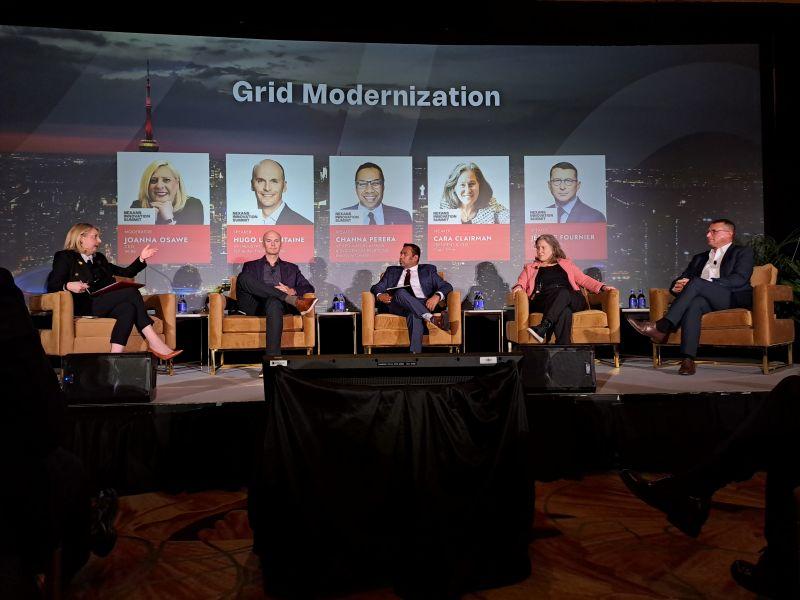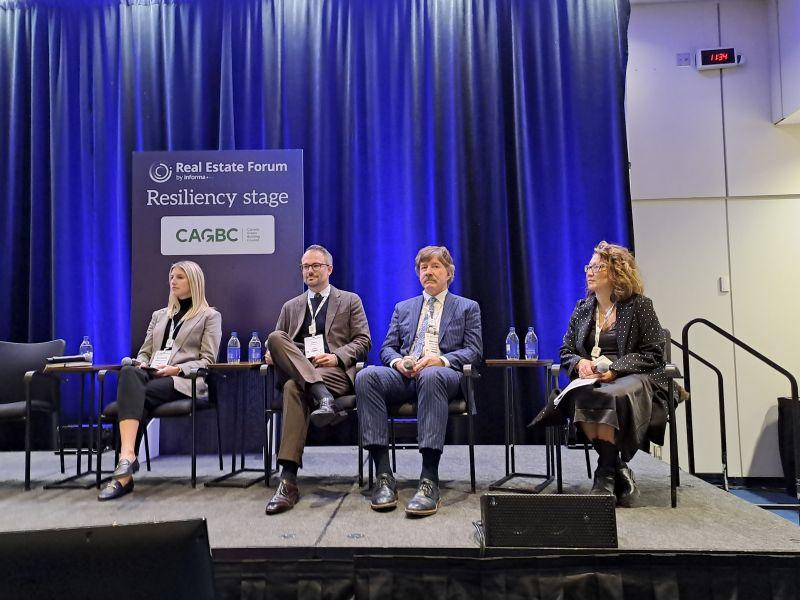
As urbanization and electrification ramp up across Canada, it is critical to modernize the grid and ensure economic equity during the transition, panellists at the inaugural Nexans Innovation Summit said.
Held Thursday at Toronto's Fairmont Royal York, the event organized by the French cable systems company centred around balancing the growth of cities and rising demand for electricity, while minimizing carbon emissions and waste.
During a panel about smarter cities, experts said the transition cannot ignore Canadians who will struggle to afford pricey retrofits and green technologies.
The speakers on a panel discussing grid modernization highlighted the need for updated infrastructure across Canada.
“It’s about what kind of cities we want to create and whether they’re cities where there’s social cohesion, where everybody belongs,” Pedro Barata, the CEO of Habitat for Humanity Canada, said during the smarter cities session.
“Or they become cities that are really divided between those who can live sustainability, have access to the right technology and those who don’t.”
Economics, equity critical to acceptance
The biggest obstacle to a net-zero pathway by 2050 is the cost, according to Riva Walia, the managing director of the France Canada Chamber of Commerce, who also sat on the smarter cities panel. But ensuring every Canadian can participate and benefit in the transition is also important, she said.
Megan Lund, the senior manager of transmission planning at Ontario's Independent Electricity System Operator (IESO), agreed with Walia. Lund said the impact on affordability must be considered by utilities when juggling electricity planning, climate goals and economic development.
“A big part of doing that affordably is through the end user, through things like rooftop solar panels and energy efficiency,” Lund said. “But if people can’t afford to put food on their table or if they’re struggling to pay the rent, how can we expect them to invest in those assets?”
More Canadians will need a stake in Canada's electrification of the economy, Barata said. This could be achieved by rethinking homes as not just shelter, but as a way to produce and conserve energy through technologies such as heat pumps and solar panels. Doing so will invite Canadians into the conversation around policies and investments.
If affordability is not baked into the shift to smarter, electrified cities, Barata warned there will be political risks. Canadians will be less likely to approve of government investments into electrification, he said.
Ensuring the grid is reliable while adding more renewable electricity sources is pivotal, according to Pascal Radue, the executive vice-president of PWR-Transmission at Nexans, who joined Walia, Lund and Barata on the panel. But Radue worries Canada’s grids are increasingly outdated and unprepared for massive expansion and upgrades. Plus, wind and solar are intermittent energy sources, presenting a challenge for achieving grid stability.
“My biggest is worry is how do we keep the grid stable and resilient in that kind of environment where the production is going to be completely different?”
How Canada's grid can be revamped for the future
The experts on the grid modernization panel looked to answer Radue’s question.
Funding to update infrastructure and meet rising electricity demand while being low-carbon will be key according to Channa Perera, the vice-president of regulatory affairs and Indigenous relations at Electricity Canada. The country will also have to be open to interprovincial transmission lines and innovations such as small modular reactors, he continued.

Governments will have to make “smart regulations” that expedite the “generational, multi-decade projects” that will contribute to the country’s clean energy goals, Perera added.
Electric vehicles (EVs) provide a “great example of how new technologies can help address both issues of affordability and issues of reducing carbon emissions,” Cara Clairman, the president and CEO of Plug'n Drive, said.
EVs can support peak shaving (reducing electricity demand at peak hours) when charged at night. By plugging in an EV when electricity demand plummets, it helps balance grid demand over the day, she explained.
Hugo Lafontaine, the vice-president of industry at Schneider Electric Canada, pitched the importance of decentralization. He listed examples such as smaller, local power plants, clean energy produced at home, EVs and microgrids.
He also highlighted a technology called dynamic line rating, which can increase the capacity of power transmission lines based on real-time conditions such as the weather. Lafontaine likened dynamic line rating to “the Apple Watch of the grid.”
Potential to create a "worldwide benchmark"
Noting the problem of Canada’s aging energy workforce, Clairman said the country’s education system has to push students into the sciences and trades from as early as middle school to bridge the expected labour gap.
Following up on Clairman's comments, Lafontaine said Canada’s culture has to be more tolerant of risk-taking and failure so the electricity sector is bringing in and retaining talent at the speed necessary to meet the 2050 net-zero target.
While there is a limited amount of time to expand and modernize Canada’s electricity grid, Jerome Fournier, the vice-president of innovation at Nexans, said Canada is well-prepared to make the transition. He cited the high level of renewable electricity generation as a major advantage.
Fournier believes Canada's grids could become “a worldwide benchmark” for a modern, sustainable electricity system in the next 15 years.










